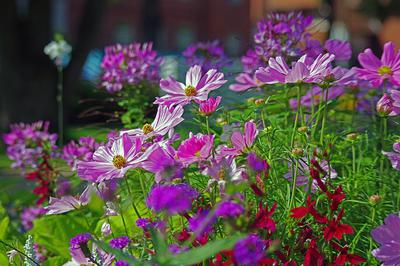by James
(UK)

Summer Flowers
Less work, more flowers, and food. That’s a win-win situation for any gardener. It’s very possible to have a low maintenance garden that practically takes care of itself after planting if you select the right plants.
Whether you want a low maintenance flower garden, vegetable garden, or a combination of the two, use these planning tips to help you achieve the best results.
Work With What You Have
If you select plants that are suited to your climate and landscape, you will have a higher success rate of surviving plants. Flower and vegetable plants will be more productive, and plants will be better able to fend off native pests.
For example, if you live in a dry climate that gets little rainfall during the summer select plants that are drought tolerant. These type of plants will need less water than other plants to survive, so that means the garden will need less watering. If you live in a low-lying area where the soil stays damp most of the time, select plants that require lots of moisture.
You will reduce your garden work-load and increase the survival rate of plants by working with the landscape you have instead of trying to make the plants adapt to the wrong environment for them.
Low Maintenance Garden Ideas
A cottage garden is a style of low maintenance gardening that has been around for centuries. A cottage garden is simply a mix of various flowering plants that have the same soil, sun and water needs planted near each other and allowed to grow freely.
There are no rules for a cottage garden, but a bloom color theme can be used to create a look of controlled chaos in the garden. The closely growing plants choke out weeds and spent blooms are left on plants to promote self-seeding.
Food forest gardens are grown much the same as a cottage garden. Plant spacing has to be done a little more carefully in a food forest garden so each plant will have sufficient room to grow.
A combination of both free-growing flowers and vegetable plants can also be created for a highly productive, low maintenance garden. Many plants provide organic benefits, such as pest control, and help a garden produce better when planted together as companions.
Growing garlic near roses keeps aphids away; nasturtiums add nitrogen to the soil and marigolds keep a wide range of garden pests away from plants. Vegetable and fruit plants also produce attractive blooms, so growing them together results in less maintenance and a higher yield in the same plot of ground.
Low Maintenance Garden Borders
There are several choices of low maintenance borders, it just depends if you want an organic or inorganic border. Monkey grass (L. muscari) makes an ideal garden border. It’s slow-growing, can withstand being trampled, self-spreading and lives for decades, adaptable to most soil and climate conditions, is evergreen and produces spikes of purple flowers in mid-summer.
Monkey grass reaches a mature height of 1 foot tall and equally as wide. Creeping monkey grass (L. spicatas) is great for planting on hillsides that you don’t want to mow. Any type of low-growing ornamental grass will make a good organic garden border.
Rock, pavers, gravel or wood can be used to create a low maintenance garden border. Rocks and pavers may have to be re-positioned occasionally, gravel replenished and wood replaced every few years, but none of these organic border items will need regular maintenance to look good.
Low Maintenance Garden Plants
Drought tolerant plants that are native to your region will always be the best choice for low maintenance. But you’re not limited to growing only native plants in your garden. Look for plants that are hardy, pest and disease resistant, plus drought tolerant for the highest rate of success with the least amount of effort. Below are a few tips to consider.
Avoid using annuals, they will need lots of TLC to keep them looking good plus they will have to be replaced each year.
Use flower bulbs instead of plants to tuck into bare areas of your garden. Bulbs require no care and will produce blooms for years.
Plant shade-loving plants under trees instead of trying to get grass to grow in these difficult areas. Select woodland plants, like hosta, that like shade and the companionship of trees.
Evergreen shrubs are carefree, slow-growing and provide shelter (and sometimes food) for birds year round.
Coneflower and cosmos love a sunny location, make good cut flowers, attract pollinators and require minimal care.
Agastache will provide fragrance and will continue to thrive even when neglected. Yarrow also thrives when neglected and has a long blooming season.
Lantana is a low maintenance flowering plant that grows best in a container. Bring the container indoor during winter for best results.
Food plants will require regular watering, but little more. Add compost to the soil to keep garden plants fed, mulch around plants with an organic mulch, water weekly and harvest the produce when ripe.
Lawn Mower Hut write detailed buying guides on the latest gardening tools and machines to help consumers make the right buying choice. They also have dozens of helpful gardening articles on lawn maintenance, weed control and garden design ideas.


